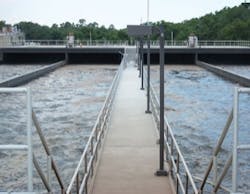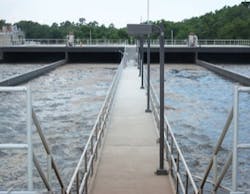ARRA Funding Boosts Water Treatment Plant Makeover By Hisham (Hutch) Musallam
When the American Recovery and Reinvestment Act (ARRA) of 2009 was signed into law earlier this year, the City of Laredo, Texas, immediately recognized that upgrading its Jefferson Water Treatment Plant was exactly the type of infrastructure/stimulus project that Congress had in mind when it passed the ARRA.
Laredo is located approximately 150 miles south of San Antonio, along the U.S. border with Mexico, and serves a population of 226,862. The city currently provides service to 52,600 water and 50,400 wastewater customers.
The city's Jefferson Street Water Treatment Plant (WTP) consists of upper and lower facilities. The lower plant was built more than 80 years ago and is no longer in service, with the exception of the six media filters, 1 million gallon (MG) clearwell, and high-service pumps which are used in the summer to help meet peak water demands. The upper plant has been in operation for more than 55 years, with some upgrades conducted in 1996. The existing upper plant consists of two rapid-mix units, five flocculators, five clarifiers, eight filters, and 2.5-MG clearwell capacity.
The Texas Water Development Board approved $48 million in economic stimulus money for Laredo to upgrade its water treatment plant through the DWSRF Disadvantaged Communities Program.
Process limitations, operational challenges, and outdated equipment have limited plant production to a maximum capacity of approximately 60 mgd (upper plant: 50 mgd, lower plant: 10 mgd).
In addition to updating aged infrastructure, ARRA emphasized helping disadvantaged communities in its project prioritization criteria. Thus, Laredo further qualified for ARRA funding through its designation by Texas as being a disadvantaged county, a characteristic of which is having above average unemployment.
Having met two goals of ARRA funding–updating infrastructure dating back to the 1920s and a recognized need for economic stimulus–the city turned its attention to probably the most critical aspect of its proposal–getting the project to "shovel-ready" status.
Project Planning
Carollo Engineers completed a Facility Evaluation and Optimization Study for the Jefferson Street Water Treatment Plant in October 2006. The existing treatment processes were evaluated, both in terms of optimal performance and in terms of their ability to comply with existing and future water quality goals and regulations, including the Surface Water Treatment Rules, the Total Coliform Rule, the Disinfectant and Disinfection By-Product (D/DBP) Rules, and the Filter Backwash Recycling Rule. A preliminary design for the improvements followed in 2007, and the final design started in 2008 and was completed in May 2009. The lower plant is an aged facility and will be abandoned following the completion of this 65 mgd upgrades project.
When the ARRA was signed in February 2009, it included funds for water and wastewater infrastructure financing to be administered through existing Clean Water State Revolving Funds (CWSRF) and Drinking Water State Revolving Funds (DWSRF). A key provision of the ARRA is that any funded projects must be ready to proceed by Feb. 17, 2010.
To ensure this requirement is met, applicants receiving ARRA funding must deliver executed construction contracts within 60 days of commitment and close the funding commitment within 30 days of executed construction contracts. This was not a problem for the Jefferson Street Water Treatment Plant Project who's bids came so timely; just one day before obtaining funding approval from the Texas Water Development Board for grant money.
The close coordination between Carollo Engineers and the City of Laredo Water Utilities Department led by Tomas Rodriguez Jr. and the dedication of its staff played a key role in helping the city get to this point by assisting in the project's planning, design, and federal stimulus funding application.
According to City Manager Carlos Villarreal, "Our team understood from the start how intense the competition for ARRA funding would be. Their efforts in building our business case and addressing all the evaluation criteria proved invaluable, and they worked tirelessly to ensure our application was the absolute best it could be."
ARRA award
On October 17, 2009, the Texas Water Development Board (TWDB) approved $48,198,000 of economic stimulus money for Laredo to upgrade its water treatment plant through the Drinking Water State Revolving Fund (DWSRF)-Disadvantaged Communities Program. The TWDB is the state agency charged with collecting and disseminating water-related data, assisting with regional planning, and preparing the State Water Plan for the development of the state's water resources. In addition, the TWDB administers financial programs for the construction of water supply, wastewater treatment, flood control, and agricultural water conservation projects.
This grant of more than $48 million is the largest to be awarded in Texas under the ARRA and one of the largest in the United States.
With construction slated to proceed by December 2009, plans have been approved to make significant upgrades to Laredo's Jefferson Water Treatment Plant, which processes 65 million gallons a day. This includes a complete rehabilitation to all existing processes, new flow split structure, new flocculators, chemical feed facilities, new filters, new clearwell, and a redo of the entire electrical system. The electrical system upgrade will include backup generators. In the event of a power failure, the city will be able to produce about 45 million gallons a day. Plans also call for the construction of new chemical feed facilities and a chemical storage area.
Team effort
City Manager Villarreal is quick to point out that many people were instrumental in the city's successful applications for the stimulus funds. Calling it a team effort, Villarreal recognized the efforts of the team and the contributions of U.S. Rep. Henry Cuellar, D-Laredo; State Rep. Richard Raymond, D-Laredo, who worked with the city to fine-tune its proposal to the Texas Water Development Board; and the city staff who completed and submitted the applications, then monitored them throughout the process.
"Laredo is a city with so much potential, we just (have) to keep taking advantage of the opportunities that are there for us," Raymond said. "This is a good example, and we're going to keep doing more." WW
About the Author:Hisham (Hutch) Musallam is a Senior Project Manager with Carollo Engineers P.C. (Dallas, Texas). His 18 years of experience in water and wastewater is highly focused on managing and directing large multidiscipline treatment plant projects in Texas.
More WaterWorld Current Issue Articles
More WaterWorld Archives Issue Articles

